Ever wonder where Italian restaurants abroad got the idea to add onions into Pasta Carbonara? While onions are absolutely not traditional in the authentic Spaghetti Carbonara recipe, it is traditional in another traditional pasta dish: Fettuccine alla Papalina! Keep reading to learn how to make the legendary Papalina Pasta recipe. Fun fact: Fettuccine alla Papalina translates to ‘Pope’s Fettuccine‘ in Italian!
This Recipe is In Our Cookbook!
Pasta Affair: 50 Authentic Italian Recipes
Seductive strands of pasta and sumptuous sauces… Are you ready to indulge in an unforgettable Pasta Affair? It’s the best pasta cookbook for beginners and a must-have for any serious lover of Italian food, featuring over 50 classic pasta recipes you can make at home! Print Hardcover or Kindle Ebook!
Watch the Video Recipe!
Prefer to watch the video recipe for Papalina Pasta? Click on the video below:
Subscribe to our YouTube Channel
More video recipes? Subscribe to our YouTube Channel (it’s FREE) and click the bell to get notifications when we release a new video recipe!
In Italian? Fettuccine alla Papalina Ricetta Originale
Papalina Pasta: the Legend
Fettuccine alla Papalina was a dish that was allegedly invented to feed Pope Pius XII’s request for a ‘lighter’ and more refined version of the traditional Spaghetti Carbonara recipe. Papalina pasta has:
- a creamy egg and cheese sauce
- prosciutto (instead of the guanciale or pancetta found in traditional Carbonara)
- Parmigiano Reggiano cheese ( instead of the pecorino cheese found in Carbonara)
- onions and butter (not in a traditional Carbonara at all!)
In our opinion, the traditional Papalina Pasta recipe is definitely not ‘lighter’ (hello: butter), but it is certainly gourmet! It is delicious and it is serious comfort food.
How to Make Papalina Pasta
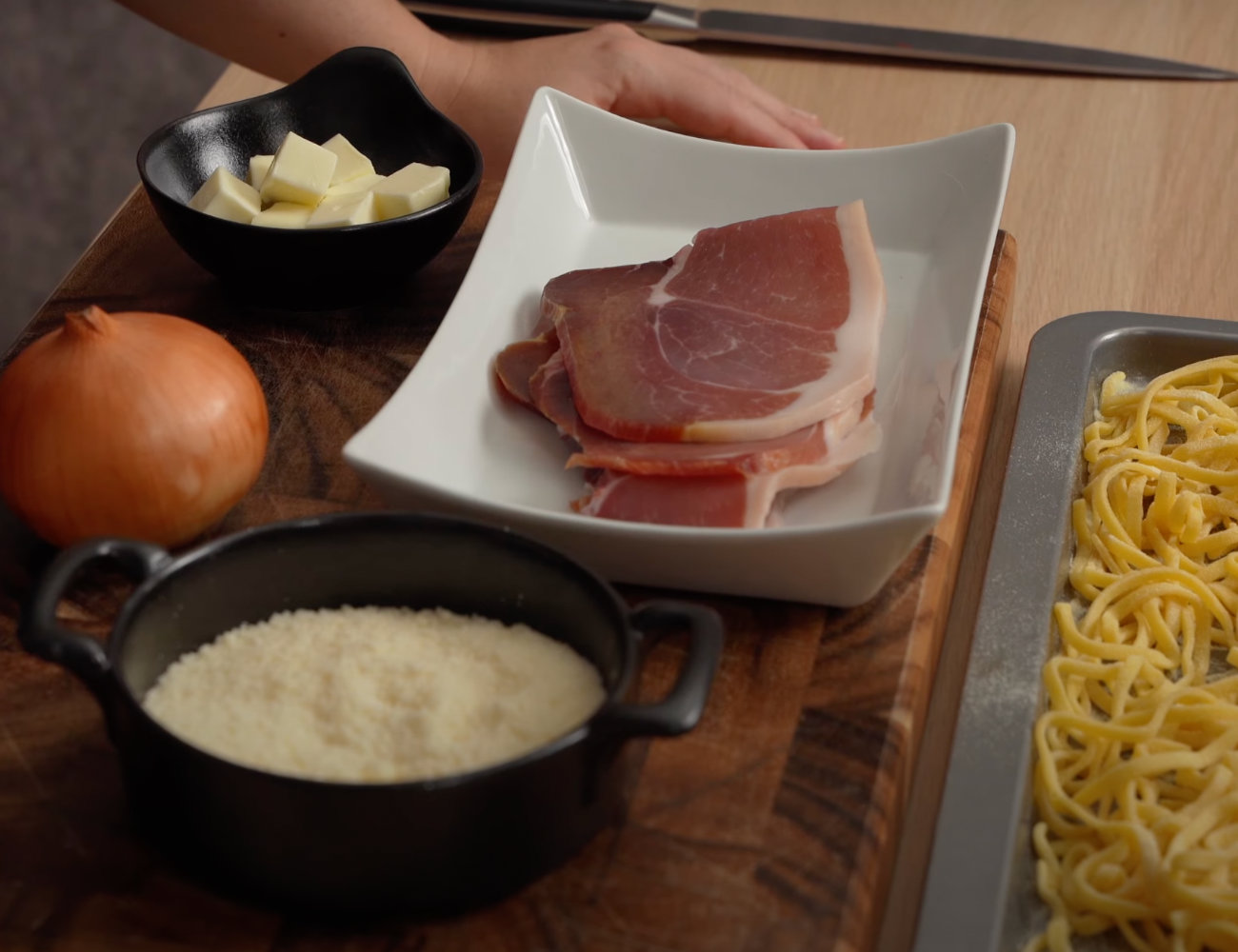
Sauté the Onion in Butter, Add Prosciutto
To make this dish, we start by sautéing minced onions in butter— with a ladle of hot pasta water.
Once the onion is translucent, we add prosciutto. For Papalina pasta, we need thick slices of prosciutto—cut into strips. The thickness of the prosciutto should be about 1/4 inch (1/2 a centimeter). One slice of our prosciutto weighed around 4 ounces (120 grams).
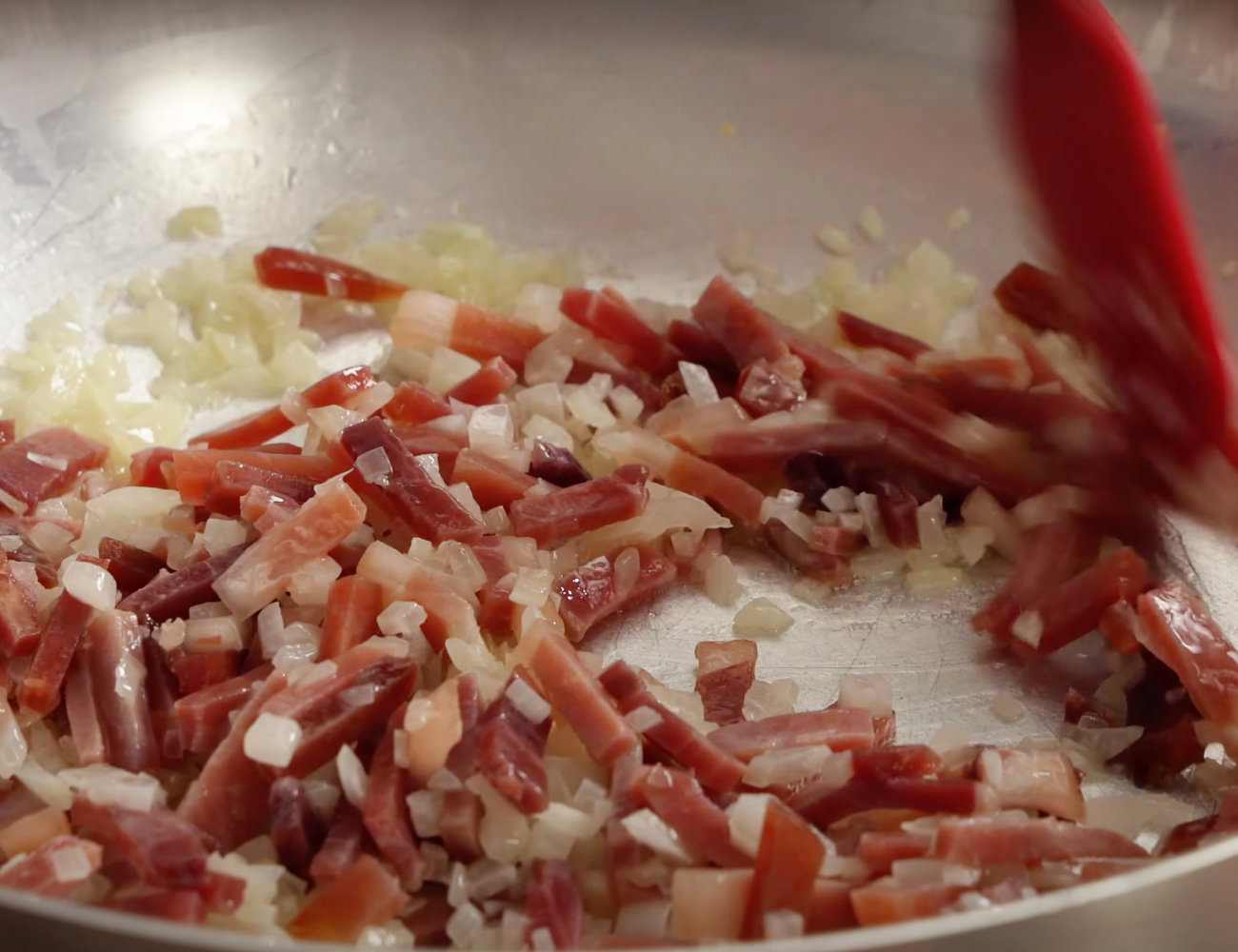
The prosciutto in this pasta recipe is cooked just to heat it and to lend its flavor to the butter and onions. We don’t need to make the prosciutto crispy, as we would with guanciale in a traditional Spaghetti Carbonara.
Prepare the Creamy Egg Sauce
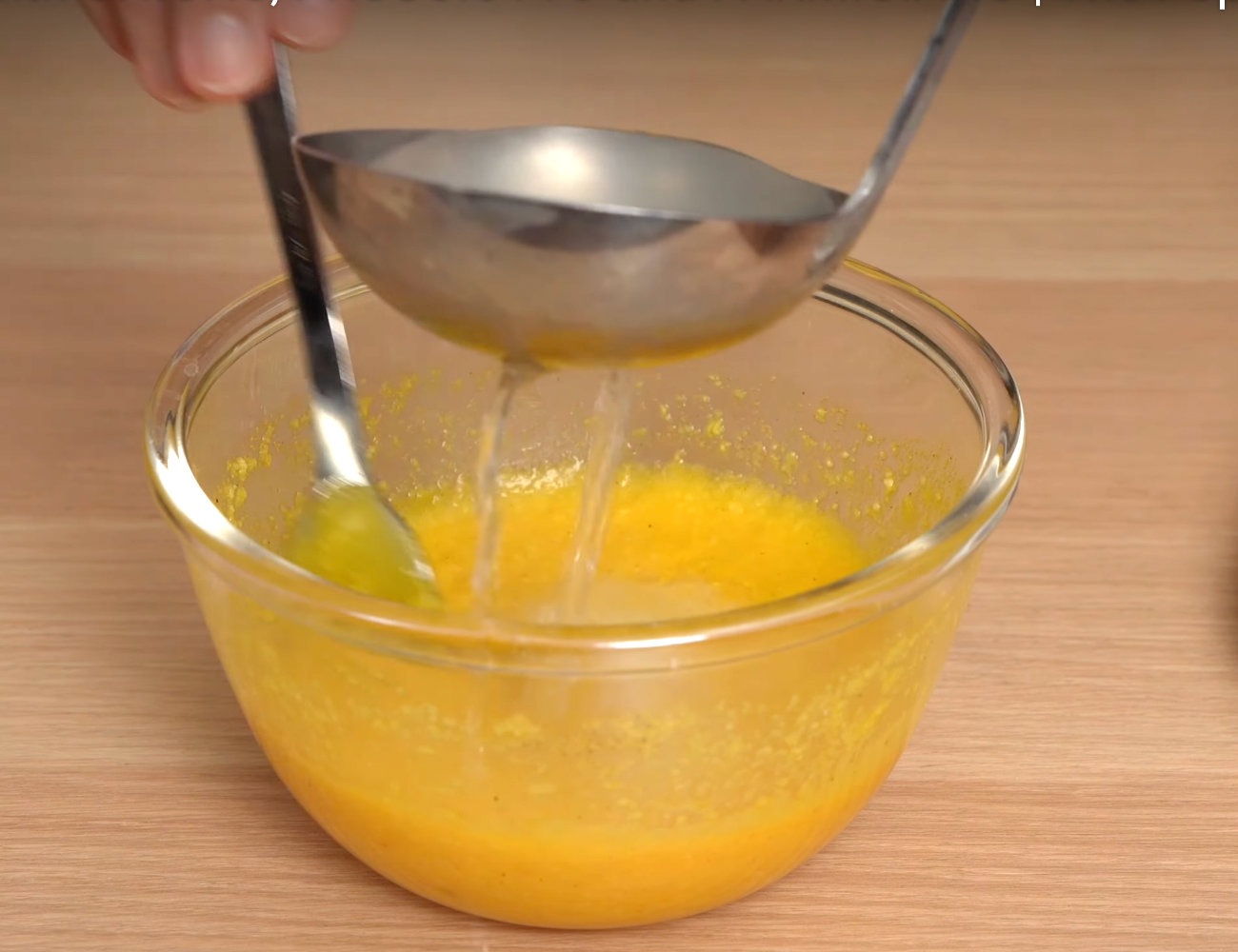
Papalina Pasta is often thought of as a ‘Carbonara’ with prosciutto, onions and butter because it does have an egg sauce that is similar to an authentic Spaghetti Carbonara recipe.
For the Papalina Pasta sauce, we follow our traditional Carbonara recipe:
- one egg yolk per person
- plus a whole egg for the pan
To create the egg and cheese sauce, we start by just mixing the cheese with the egg.
While pecorino cheese is traditional for Spaghetti Carbonara, finely grated Parmigiano Reggiano cheese is mixed with the egg to make Papalina Pasta sauce. For the best flavor, freshly grate the cheese. We’ll also need a bit of hot pasta water for our egg sauce, but first we need to….
Cook the Pasta
The pasta traditionally served with Papalina Pasta is fettuccine!
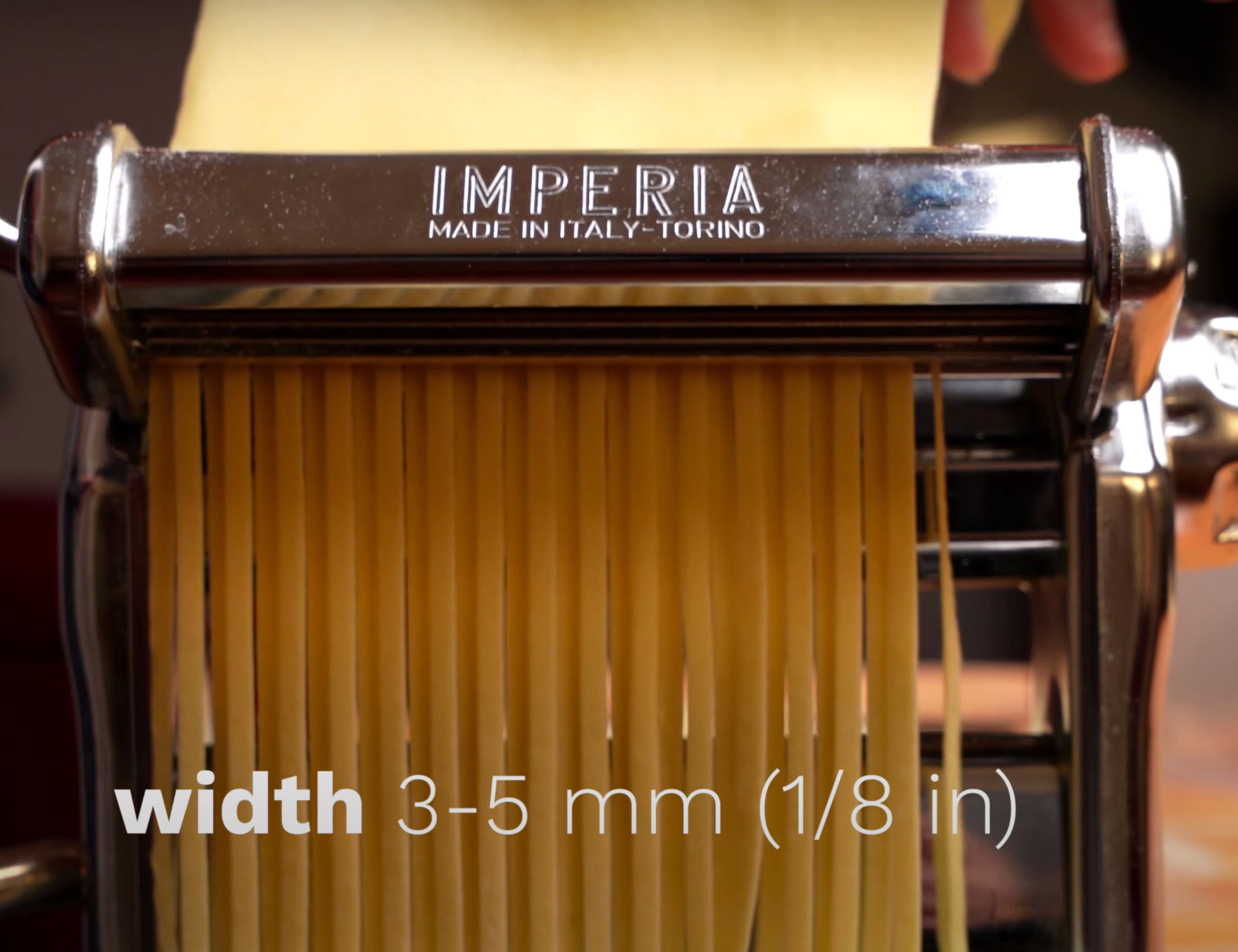
For this dish, we cook the fresh fettuccine almost entirely in the pot. This is in contrast to some other Roman pasta recipes like Spaghetti Cacio e Pepe, in which the pasta is only partially cooked in a pot and then transferred to a skillet and finished in a sauce or infused water.
Fresh Fettuccine Cooks Quickly!
Fresh fettuccine requires only two to three minutes to cook. Add less salt to the pasta water than you normally would—to account for the fact that prosciutto is quite salty and will add salt to the finished dish.
Finish the Pasta with Sauce
While the pasta is cooking, we slowly add a little less than a ladle of hot pasta water to the egg and cheese—mixing continuously! This will help the egg and cheese to bind together. By adding the water slowly a bit at a time and mixing constantly, we prevent the eggs from reaching a temperature at which they would coagulate. We don’t want a clumpy egg sauce!
When the fettuccine is al dente, strain it and add it to the onion/butter/prosciutto in the skillet. After mixing to combine the pasta with these ingredients, remove the skillet from the heat and add the egg sauce—off the heat!
Eggs begin to coagulate at a temperature of about 63 degrees Celsius (145 degrees Fahrenheit)— so it’s important not to cook the eggs over direct heat.
Carbonara: Frequently Asked Questions
Are the eggs in Carbonara sauces safe to eat?
Eggs that aren’t thoroughly cooked do carry the risk of foodborne illness like salmonella.
The FDA recommends heating eggs to a temperature of 160° F in order to be safe from foodborne illness. This is tough to do in a carbonara sauce manually without cooking the eggs—and ending up with clumpy sauce.
However, if you use a sous vide or another machine that can continuously whisk the eggs while maintaining a specific temperature, it can be done. We’ll address this technique in another post.
How is an Authentic Italian Carbonara Recipe Prepared?
You are looking for this Spaghetti Carbonara recipe —considered traditional in Italy today!
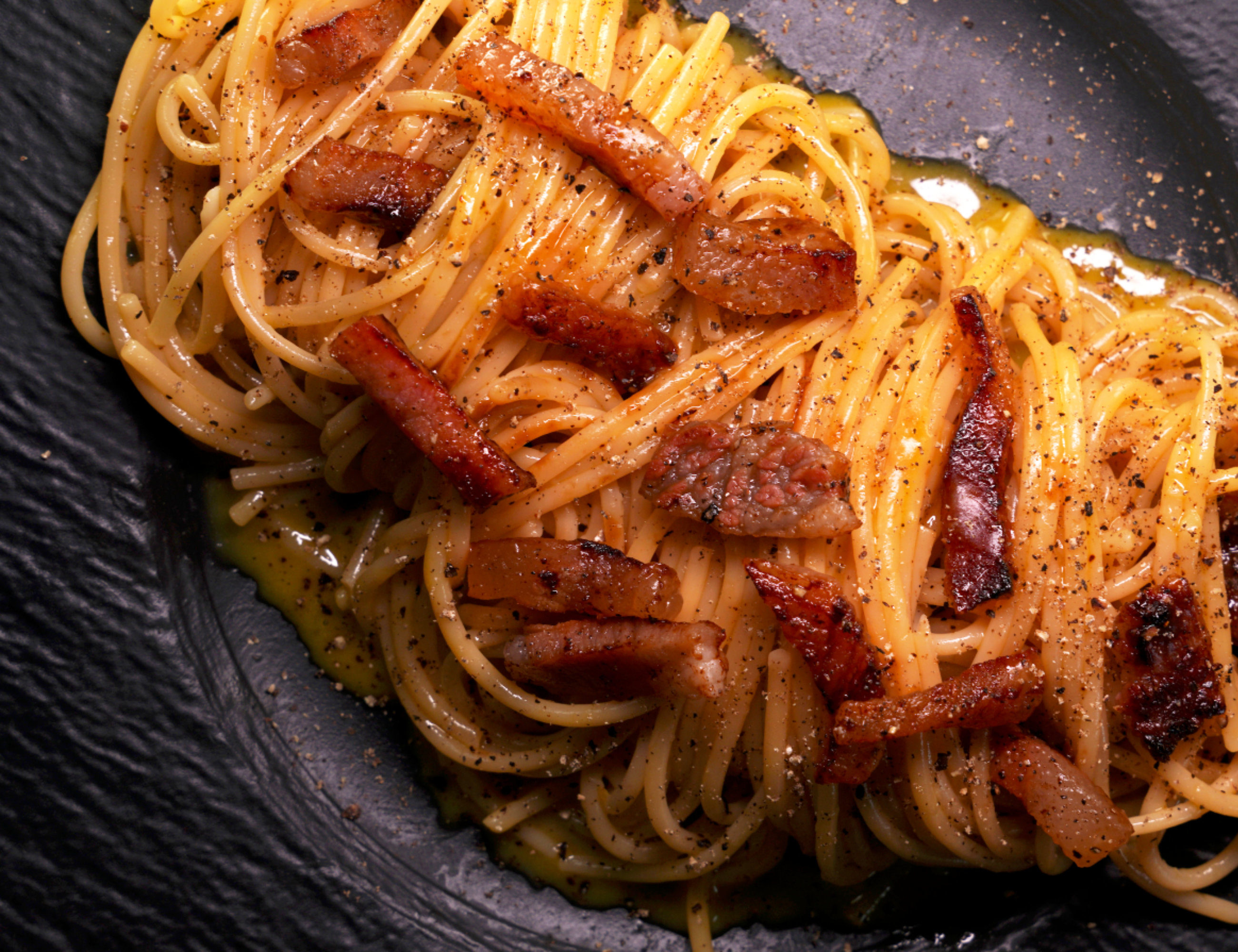
Is there a Spaghetti Carbonara with Cream and Bacon?
If the Carbonara recipes that you love have American bacon and cream, you are probably looking for something like the WWII Spaghetti Carbonara recipe!
This ‘American-style’ Carbonara is in fact one of the origin stories for Carbonara, and we have re-created the recipe for you using the memoirs of the Italian Chef who said he invented it!
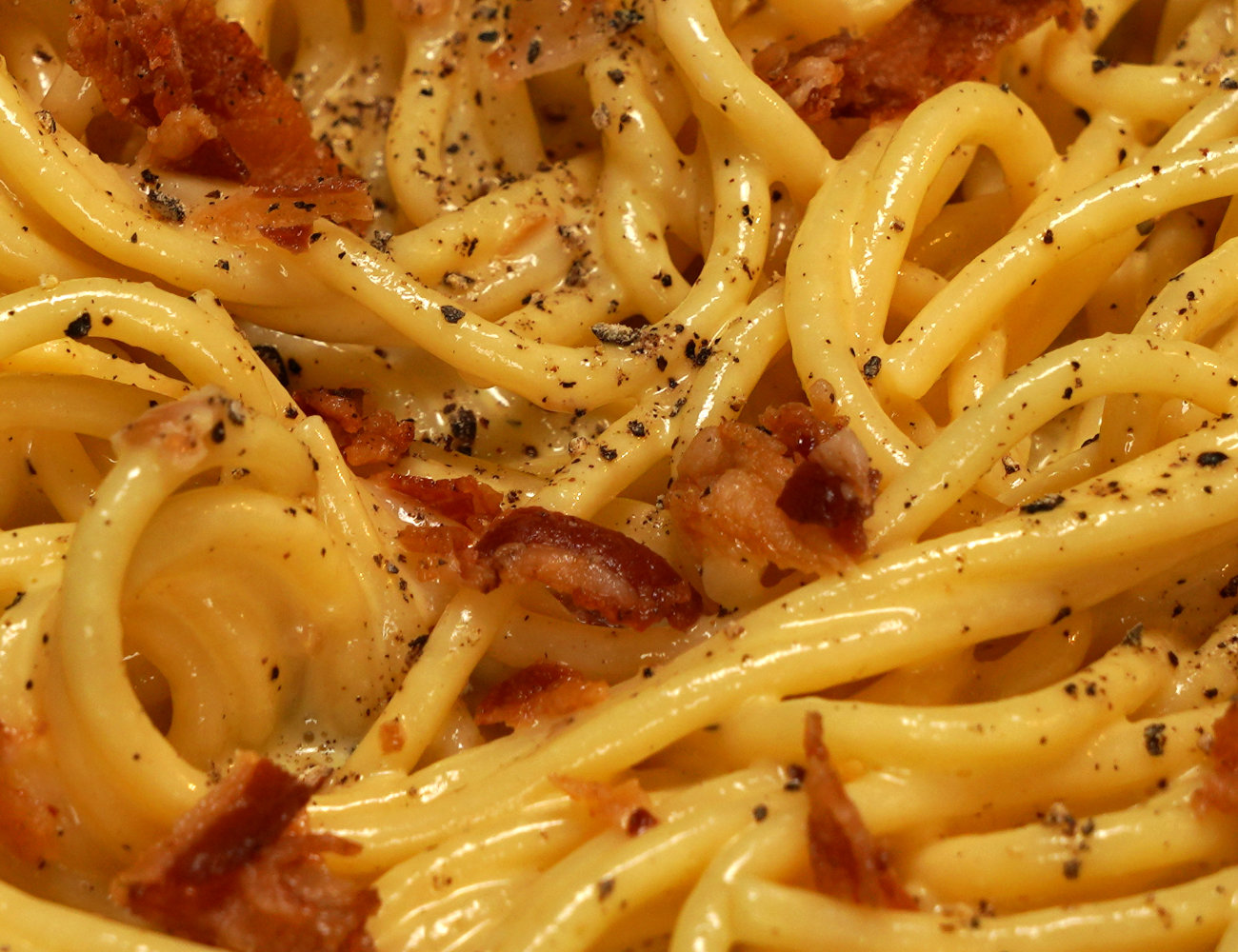
Discover More Cheesy Italian Food Recipes
As an Amazon Associate, we earn from qualifying purchases. This means at no extra cost to you, PIATTO may earn a small commission if you click the links and make a qualifying purchase.
Papalina Pasta Recipe
Equipment
- 1 stock pot for cooking the pasta
- 1 large skillet or pan
Ingredients
- 1 onion minced
- 7 oz prosciutto thick slices, cut into strips
- 3 tbsp butter
- 4 egg yolks
- 1 whole egg
- 3 oz Parmigiano Reggiano cheese finely grated
- 1 tsp black pepper freshly ground
- 1 pinch fine salt or to taste
- 14 oz fettuccine pasta
Instructions
Prepare the Ingredients
- Mince the onion.

- Cut the thick prosciutto slices into strips. Finely grate the Parmigiano cheese, if it is not already.

Prepare the Egg Sauce
- Combine the egg yolks and whole egg with: the black pepper, finely grated Parmigiano cheese and a pinch of salt. Mix until smooth. Set aside.4 egg yolks, 1 whole egg, 1 tsp black pepper, 1 pinch fine salt, 3 oz Parmigiano Reggiano cheese

Heat the Pasta Water
- Bring the water for the pasta to a gentle boil. We need the hot water for the next step. However, fettuccine pasta cooks quickly so don’t start cooking it yet. In the meantime…
Sauté the Onions and Prosciutto
- Melt the butter in a large skillet. Add the minced onion and a ladle of hot pasta water. Cook the onion over medium heat until translucent and tender.3 tbsp butter, 1 onion

- Then, add the strips of prosciutto to the pan as well and mix them with the onion. In the meantime…7 oz prosciutto

Cook the Pasta
- Cook the fettuccine in lightly salted, boiling water according to package instructions for al dente pasta. Fresh fettuccine cooks in 2-3 minutes.Add less coarse salt to the pasta water than usual because both the Parmigiano Cheese and the prosciutto are quite salty.14 oz fettuccine pasta

Finish the Pasta
- Add a little less than a ladle of hot pasta water to the egg sauce. Drizzle the water in slowly and mix continuously to prevent clumping. The eggs will be liquid-y and smooth.

- Add the drained, cooked fettuccine to the skillet and mix to combine. Remove the skillet from the heat and quickly stir in all of the egg sauce.

- Serve immediately and buon appetito!

Video
Notes

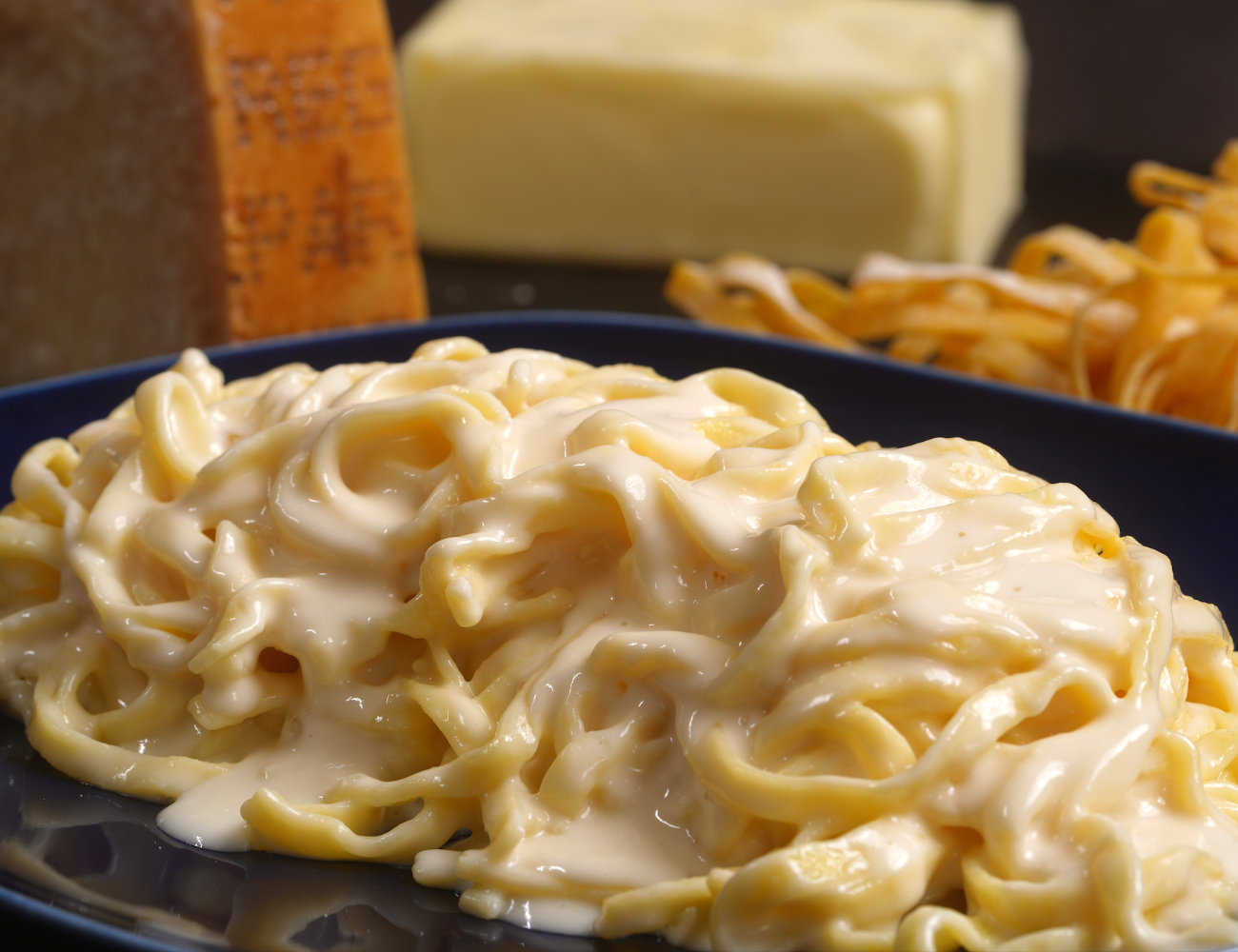
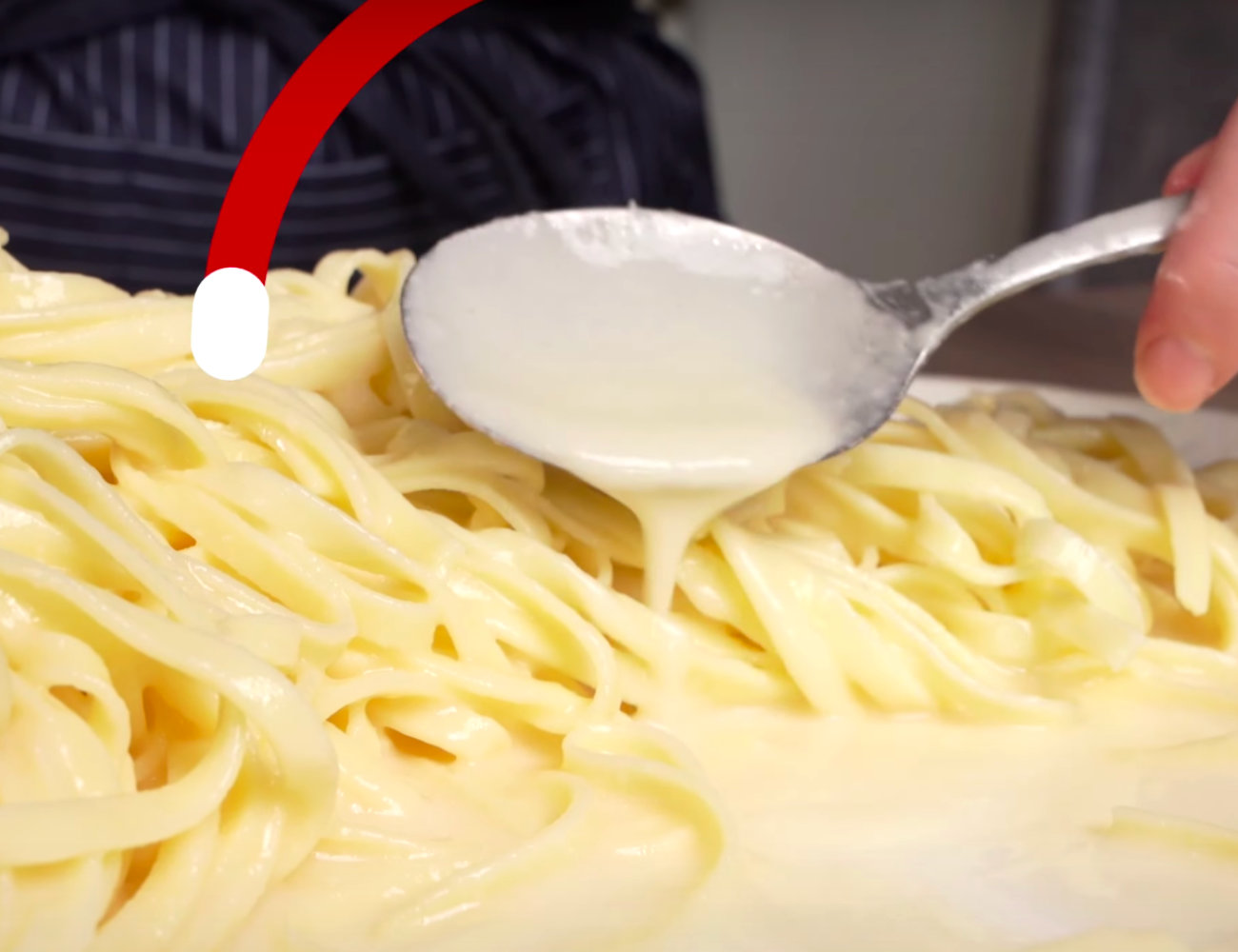
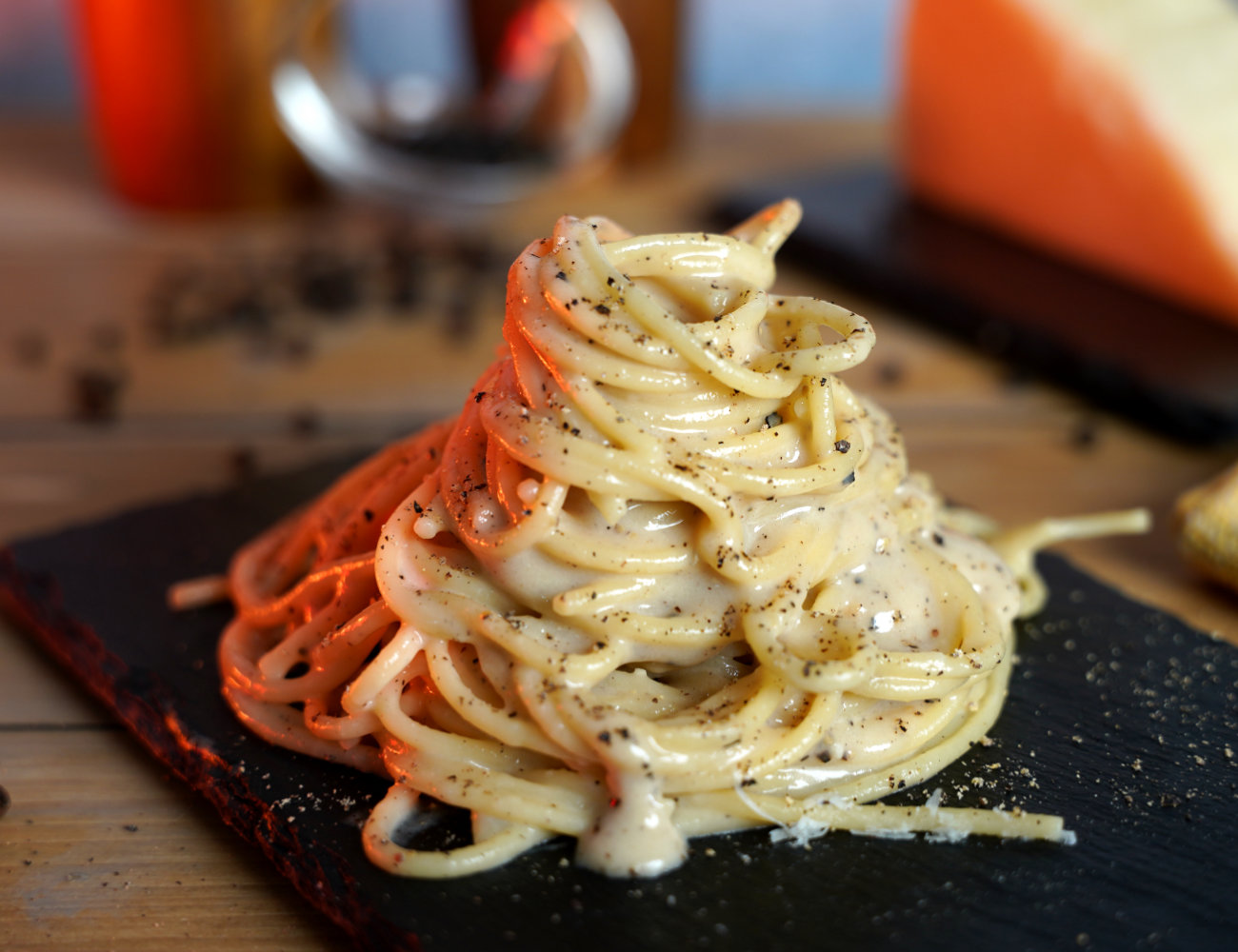
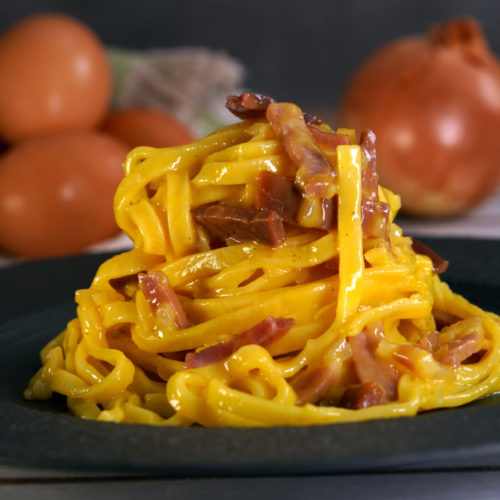
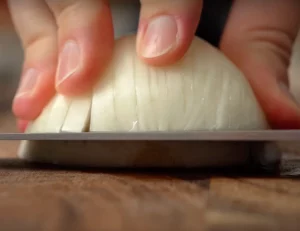
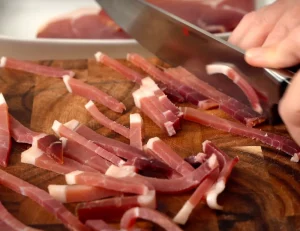
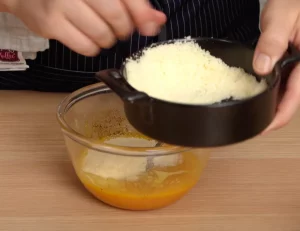
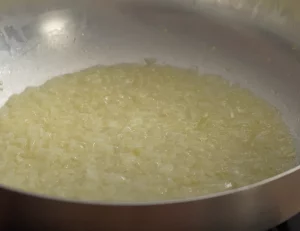
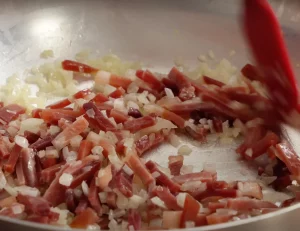
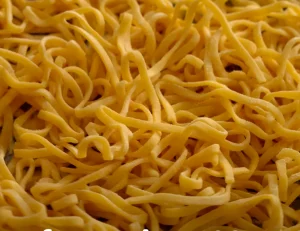
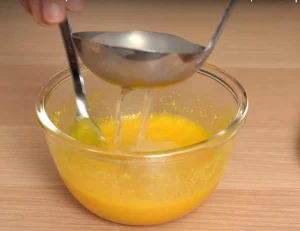
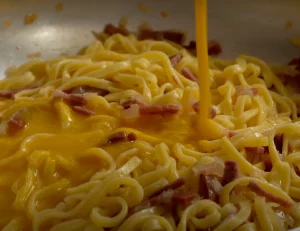
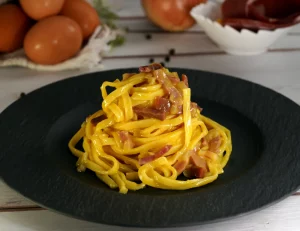

“spettacolare”
“Bravo. Ben fatto.”
“Piatto Sublime. Se posso… troppa/issima cipolla! 😉
“perfetto !
grazie”
“Che spettacolo! le voglio rifare”
“Wow!! Increíble!!”
“👏👏👏👏👏🇮🇹🇮🇹”
“Love it ❤️”
“Wowww this recipe looks so delicious, thank you for sharing this with us”
“Complimenti per questa ricetta, si presenta benissimo da provare sicuramente !!”
“Mi è piaciuto lo sprezzo con cui ti sei riferito a piselli e panna ahahah”
“Papalina duodecima, n’ho l’acqua al bocca 😛”
“Ricetta fantastica, e anche con una connotazione storica. Mi permetto di fare un piccolo appunto: va precisato il dettaglio importante che il battuto d’uovo va aggiunto a fuoco già spento, proprio per evitare che l’alta temperatura porti alla coagulazione che poi dà un effetto tipo frittata o uovo strapazzato.”
“Bravo! Finalmente la ricetta originale condita dalla storia originale!”
“Buonissime davvero 🙂”